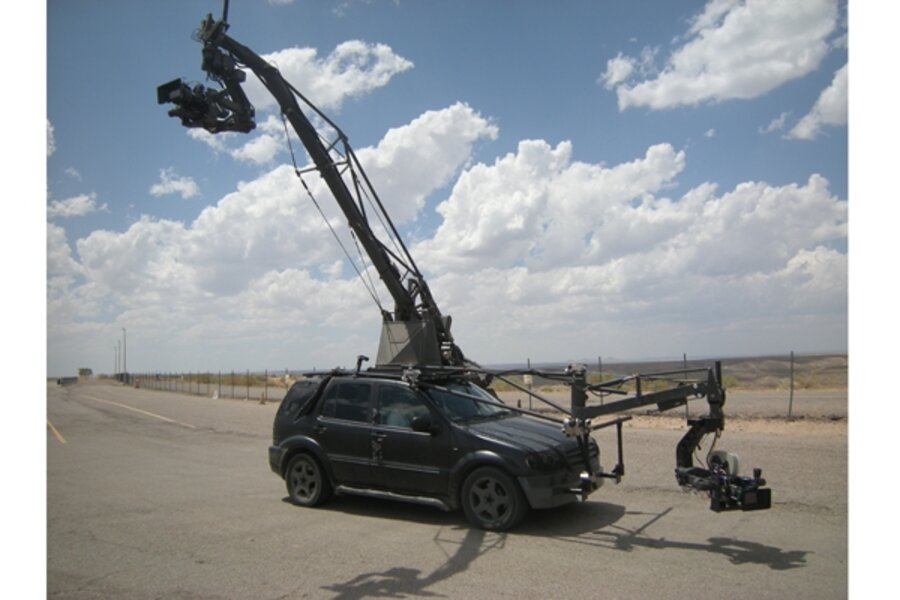Ultimate Arm: Capturing action from every angle
Loading...
| Lincoln, Mass.
Cars hurtle down a narrow road, inches from the steep cliffs of Italy’s Amalfi coast. Shots are fired from the speeding vehicles. After dodging bullets, one of the cars slams James Bond’s vehicle into oncoming traffic, which the secret agent narrowly avoids. The action is frantic, but the scenes are smooth and seamless.
To pull off these opening shots from the latest 007 flick, “Quantum of Solace,” director Marc Forster called in the Ultimate Arm. This remote-controlled camera crane swings through hectic action scenes with precision, capturing footage from right in the middle of the 60-m.p.h. car chase.
No camera car could do that, says Dean Bailey. As a professional stunt driver, Mr. Bailey navigated the Ultimate Arm (UA) through Bond’s high-speed pursuit. More recently, he used it to capture scenes for Mel Gibson’s upcoming film “Edge of Darkness.”
During a long night of filming last fall in residential Lincoln, Mass., Bailey showed why the UA has become one of the most sought after tools for Hollywood action movies.
The camera crane stretches out from a black Mercedes SUV like a scorpion tail. Instead of a stinger, the 22-foot arm can cradle a film, digital, or 3-D camera at its tip. Weighing up to 650 pounds, the UA can make a complete rotation around a vehicle in less than five seconds.
The camera can be lowered to mere inches above the pavement, and in the right circumstances, even five feet below ground level. Both the crane and camera cradle are gyrostablized to help achieve a stable image even at long focal lengths.
As Bailey puts it, “I don’t care how rough the road and how aggressive the driving, the image is super stable.”
Roots in Russia
UA is the brainchild of two film technicians who met in Hollywood. Lev Yevstratov spent 21 years teaching, designing, and tinkering at the Bauman Moscow State Technical School, arguably the best mechanical-engineering school in Russia. His work focused on military applications for gyroscopes, such as in navigation and guidance systems for missiles.
After receiving his PhD, Mr. Yevstratov left academia to pursue a career behind the scenes of TV shows and movies. One particular gig brought him to Los Angeles, where he met George Peters, the key grip who was also interested in camera motion.
They both knew that there must be a better way to rig camera cranes. And with Mr. Peters’s history in film and Yevstratov’s background in gyroscopes, they decided to work together to design a solution.
After a few years and some false starts, Peters helped Yevstratov move to the United States, and they went into business together.
While Peters rustled up investors in the US, Yevstratov corralled a team of designers in Russia.
As Yevstratov puts it, the project took 18 months of “working on the computer at home, calling and e-mailing to Russia, going there, buying and shipping parts, getting equipment to the US, opening shop, assembling, fixing, adjusting, and remaking some parts.”
By 2005, the Russian team finished the prototype. Since then, all seven of the cranes have been built in Russia.
“I think they have about six to eight people working over there,” says Peters. “I feel very blessed that we had so much help from Russia. I do not think it could have been done as fast here.”
The arm in action
The UA is used mainly for filming high-speed chases, by cars, helicopters, or boats. For car chases, they often attach it to a Mercedes SUV because they “needed a vehicle that could handle the weight and still go really fast and not feel like it was going to tip over,” says Peters from his office in Oxnard, Calif.
Yevstratov’s team transformed their Mercedes by adding a new suspension, tires, brakes, a supercharger that ramps up the horsepower from 342 to 550, and a built-in roll cage to support the crane and protect the passengers in case of a rollover.
The cramped interior is jampacked with all the equipment needed to operate the crane, camera, and the special “Levhead” cradle, which can turn on three axes. They tucked joysticks, film equipment, hard drives, a radio system to the stunt car, and four TV screens into the car – and the SUV still seats five people.
“It is just plain insanity inside the UA,” says Peters. “Things happen in one second. Sometimes there is a lot of yelling and commotion going on and you have to take it all in.”
When traveling to locations or not in use, the UA has its own custom-built truck, designed by Bailey, complete with its own generator and complete repair facility. This way, when it comes time to start shooting, “we’re set up to be very ready to go. You unload the car, put the camera on, and you’re ready to shoot. The setup time is virtually nil,” says Bailey.
Production crews can rent the UA, with prices based on the intensity of the product and how many features the film needs. Either way, the price isn’t cheap. The “Levhead” alone costs $1,300 a day to rent.
UA’s résumé
Since that first prototype, the seven UAs have shot countless automobile commercials, as well as scenes from “Batman Begins,” “Miami Vice,” “Mr. & Mrs. Smith,” “The Mummy,” and a boat scene in “Quantum of Solace.”
In 2006, the team won an Academy Award for Technical Achievement. The Academy of Motion Picture Arts and Sciences, which holds the Oscars each year, called the Ultimate Arm “a significant improvement in camera car technology that solved many problems inherent in chase vehicle filming.”
Peters’s translation: The UA is going to make traditional camera cars obsolete.
“I am not an engineer or scientist like Lev,” says Peters. “I completely took on this business on faith; I knew it would help me pull through any kind of difficulty. It’s working.”





